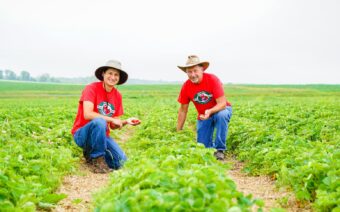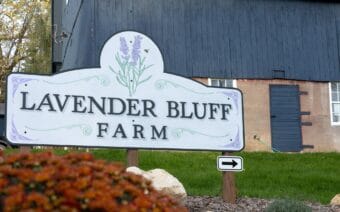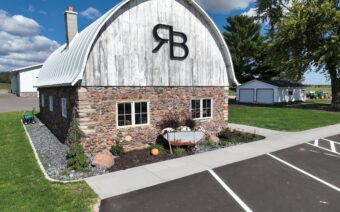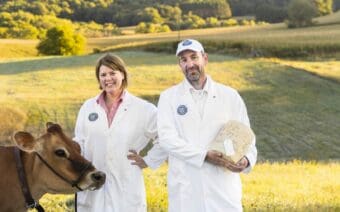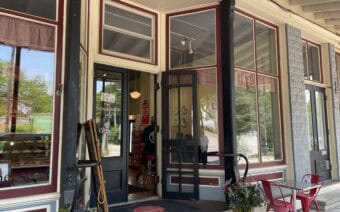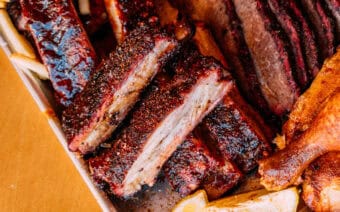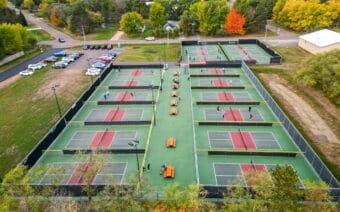
February 19, 2024
CUMBERLAND – With the weather warming during the day and the nights remaining colder, the maple syrup season is fast approaching.
Steve and Alison Anderson of Anderson’s Maple Syrup, a family-run maple syrup operation that started in 1928, said the season never gets old.
“It’s always an exciting time of the year,” Steve said. “Though we aren’t in the production of making maple syrup anymore, we are busy packaging and marketing our syrup five days a week.”
The pair have run the business, located at 2388 40th St., since the late 1990s.
Operations
As mentioned, Steve said Anderson’s is not technically a maple syrup producer, but its trees are used in the process.
“Someone else is managing our trees,” he said. “We probably stopped producing maple syrup (ourselves) in the late 1980s or early ’90s. At one point, we had as many as 18,000 taps.”
Steve said Anderson’s, however, is the largest packager of maple syrup in the Midwest.
“We sell maple syrup all over the United States and some overseas,” he said. “I was recently on the phone with someone from Poland who wants to buy a container full.”
Though Anderson’s is not a producer anymore, Steve said the family is still heavily involved with their trees and knows a great deal about the process.
“It’s not so much the age of the tree (we look at when tapping) but more about the size – we like them to be at least 10 inches across,” he said. “That’s the minimum we’ll tap.”
Steve said they also look at the tree’s health.
“If it’s not quite up to par, we’ll wait a few years until it’s a bit healthier,” he said.
Steve said Anderson’s has an inventory of about 4,000 trees.
“We work with a lot of local producers who sell us their syrup (much of which is collected from our trees),” he said. “We package syrup here five days a week, year-round – we focus on packaging and marketing. We rent the trees we have to other people who then turn the sap into syrup and sell it back to us.”
Steve said Anderson’s utilizes a vacuum system where the sap is sucked out of the tree and sent to a central location.
“I’d estimate 95% of the world’s maple syrup is done through the vacuum system (now),” he said. “Our trees are (already) tapped – whether that was the right decision, we’ll find out in two or three months.”
Steve said some producers don’t tap until March 1, no matter what, and some start when they can.
“I’m guessing most of the good-sized producers in the state started their tapping process in late January,” he said.
Steve said he thinks many producers are not done tapping all their trees yet.
“They hurried up and got their taps in and collected sap, but some are placing their bets on the cooldown coming, and then they’ll get the rest of their trees tapped,” he said. “We don’t know the total effect (of this weird weather) yet.”
Steve said the ideal weather for optimal sap running is “freezing hard at night and warming well above freezing during the day.”
“Even (getting into) the upper teens or low 20s at night and getting to the 40s during the day (works),” he said. “If the sun doesn’t shine much, temperatures right at freezing during the day won’t do much.”
Sustainability
Steve, who is currently the president of the Wisconsin Maple Syrup Producers Association, said Anderson’s is also “very sustainable in its efforts.”
“We recently installed solar panels to help with its sustainability efforts,” he said. “On a good day, the entire building is run on the energy from the solar panels. Most of the time, anywhere from 50-75% of the power comes from the panels. It depends on how much sun we have.”
According to the company’s website (andersonsmaplesyrup.com), Anderson’s is climate-positive – which means it creates more positive environmental outcomes than negatives.
“Of course, we still use some natural resources and produce some carbon, but overall, the trees we work so hard to keep healthy absorb 1.25 times more carbon than we produce,” Steve said.
How it began
In the family for almost 100 years, Steve said his grandparents, Paul and Clara, began making maple syrup as a hobby to put something sweet on the family’s breakfast table.
“It was even before 1928 they made maple syrup, but we say 1928 because that’s the year they moved onto the property we’re currently on,” he said. “As a kid growing up, he made syrup at his childhood home, which is a quarter mile down the road.”
Steve said his grandparents – and his own parents, Norman and Janice Anderson – passed down a lot of stories over the years.
“We certainly heard about the good and bad years,” he said. “We’ve got some trees in the woods that have names because of my grandfather. We have ‘Uncle Arnold’s Tree’ and ‘Grandpa’s Tree.’ They were good trees, so they wanted to name them.”
Steve said Grandpa’s Tree got knocked down in a 2019 wind storm, but Uncle Arnold’s Tree is still there.
“My Uncle Arnold used to help a bit in the process, so they kept a good eye on that tree, he said. “That tree is probably older than 150 years.”
In the mid-1930s, Anderson’s began selling the entire year’s supply of syrup to Hoves Grocery Store, which would later become Lunds, now part of the Lunds & Byerlys chain.
Steve said Paul eventually added other routes through parts of Wisconsin and into Northern Minnesota.
The syrup distribution business grew, and in the late ’40s, the family decided there was a greater opportunity to be had in the maple syrup business than in farming.
“They took a giant step, sold the cows and jumped headfirst into the maple syrup business,” Steve said. “They knew this was a huge risk, but they worked hard and built the business that thrives today.”
Now, Anderson’s Maple Syrup products can be found in thousands of retail locations across the country and are widely used as an ingredient in numerous products, from baked goods and meats to beer and mixed drinks.
Other endeavors
Steve said today, there is more to Anderson’s than just maple syrup.
“For about 10 years, we’ve sponsored, in some way or form, someone from NASCAR,” he said. “We’ve been on a Kenny Wallace car in the Busch Series, Ron Hornaday drove a truck in the series for a few years and Mike Wallace drove the truck one year in Talladega and won.” As far as they know, Steve said they are the only maple syrup company to ever win a NASCAR race.
“We’ve backed away from that – it was getting too expensive, and it wasn’t giving us the pull-through we wanted,” he said. “Now we sponsor some drivers locally.”
Anderson’s is also fueling endurance athletes worldwide, Steve said, in the form of Pure Fue – maple syrup served in a convenient, small pouch.
“We’ve always been a small industry – and we still are – but we never had the money to spend on research to know the positives and negatives of maple syrup,” he said. “The last 10-15 years – in large thanks to Canada because they put more money into the maple syrup industry than the U.S. – it’s gotten more exposure. Everyone is familiar with (a popular energy pack called) ‘GU,’ but that’s hard to swallow and has to be chased down with a lot of water.”
Steve said maple syrup could be a better option.
“Maple syrup has all the same nutrients as GU, but it’s easy to swallow,” he said. “You can put it on your pancakes and don’t have to chase it with water. Also, it doesn’t freeze. The GU stuff will turn solid at -10, but maple syrup is still liquid at that temperature.”
Steve said below-zero temperatures might not necessarily be a problem with runners, but Anderson’s also works with the folks at the American Birkebeiner, North America’s largest cross-country ski race that takes place in northern Wisconsin at the end of February.
“We’ve been working with them for about eight years now,” he said. “The only thing Pure Fuel is missing, it doesn’t have much for electrolytes. People are generally drinking something else for that, so we’re not too concerned about that. Some add to the maple syrup packs, but we like to keep it pure and clean.”
For more details on Anderson’s Maple Syrup and its varying offerings, visit its website or find it on Facebook.
 Fifth Ward Brewing Co. raises a glass to growing business
Fifth Ward Brewing Co. raises a glass to growing business Multi-generational tree farm kicks off holiday season
Multi-generational tree farm kicks off holiday season


